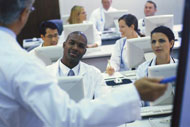
-
 Contractual Partners
From this section it is possible to access to a description of each contractual partner of the Softis-Ped project.
Contractual Partners
From this section it is possible to access to a description of each contractual partner of the Softis-Ped project.
-
 Lecturers
From this section it is possible to access to the information about the paediatric lecturers involved in the Softis-Ped Project in the 5 European countries involved.
Lecturers
From this section it is possible to access to the information about the paediatric lecturers involved in the Softis-Ped Project in the 5 European countries involved.
-
 Residents Working with Children Information
From this section it is possible to access to the information about the paediatricians involved in the Softis-Ped Project in the 5 European countries involved.
Residents Working with Children Information
From this section it is possible to access to the information about the paediatricians involved in the Softis-Ped Project in the 5 European countries involved.
-
 Paediatric students
From this section it is possible to access to the information about the paediatric students involved in the Softis-Ped Project in the 5 European countries involved.
Paediatric students
From this section it is possible to access to the information about the paediatric students involved in the Softis-Ped Project in the 5 European countries involved.
-
 Associated Partners
As a result of the exploitation activity a number of associated partners officially joined the project in order to contribute to the improvement of the project impact on their target groups and to ensure the project sustainability by continuing using the project deliverables in the next years.
Associated Partners
As a result of the exploitation activity a number of associated partners officially joined the project in order to contribute to the improvement of the project impact on their target groups and to ensure the project sustainability by continuing using the project deliverables in the next years.
Events
The Softis-Ped project has been promoted trough conferences and articles.
-
 Conferences
The Softis-Ped project was presented in a number of events in order to report about the activities carried out and the results achieved
Conferences
The Softis-Ped project was presented in a number of events in order to report about the activities carried out and the results achieved
-
 Training Activity
The training activity 'Soft Skills in Pediatrics' was held at the University of Medicine and Pharmacy of Tirgu Mures (RO)
Training Activity
The training activity 'Soft Skills in Pediatrics' was held at the University of Medicine and Pharmacy of Tirgu Mures (RO)
-
 Press Review
The Softis-Ped project partnership made contacts with web sites focusing on the fields of paediatrics and education
Press Review
The Softis-Ped project partnership made contacts with web sites focusing on the fields of paediatrics and education
This section of the Softis-Ped portal provides administrative information for the project contractual partners and for the European Commission and it is password protected.
Training of Lecturers
Homepage > Training > Training of Lecturers

This training package is addressed to lecturers and trainers in the field of paediatrics on how to assist paediatric undergraduate and resident students in developing and consolidating their soft skills for improving the quality of paediatric services.
Communicating with Peers
- Time management: this person should be good at scheduling a timetable, trying not to make his/her companions “ wasting” their time and working more effectively.
- Quick decision-making: someone who makes quick decisions when required, always considering the facts and alternatives available
- Emotional intelligence: a person able to create a pleasant human environment for work, showing humility, empathy, friendliness, unselfishness. We can also describe this person like someone polite, easygoing … He/she would inspire a strong desire to succeed among team members.
- Resilience: respond effectively to disappointments and setbacks, receive criticism in a good manner
- Flexibility: be adaptable and receptive to new ideas, adjust to continuous changing work demands and circumstances
- Persuasion: gain agreement to proposals and ideas, stand ground in the face of opposition
- Initiative and creativity: someone proactive and self-starting, seizes opportunities and acts upon them
- Leadership: people who create the conditions that allow people to grow and do their best. It also includes training and mentoring new and young team members
- Cultural and diversity awareness: communicates well with diverse people, shows respect to others opinions or values
- Conformity to social rules: someone who governs his dress, body language, tone of voice and vocabulary according to the particularity of each situation
- Building external working relationships: a person who mantains positive relationships with people beyond his own team, forges useful partnerships with people across other organizations
- Conflict resolution: that kind of people who promote harmony and consensus through diplomatic handling and disagreements
- Inspiring moral trust: this person shows loyalty within the team, shares information, treats all fairly, keeping his/her word, …
- Inspiring competence-based trust: inspires confidence in his/her own capacitites and skills, underlying his/her competences and values to others
- Strategic thinking: someone able to think at a big level, with a long-term view of the future
- Assertiveness: someone who defends his/her rights, expresses his/her opinions and makes suggestions truthfully without agresiveness or passivitiy, showing respect to others
- Courtesy: frequently using the words “please”, “thank you”, “excuse me” in dealing with colleagues and patients
- Soft skills: what you need to know and learnyou can use it to learn a little more about soft skills and practice with some examples
- Scott J. How healthcare leaders can increase emotional intelligence. Radiology Management. 2013; (Supplement):11-16.
- Treem Guerin T. Relationships matter: the role for social-emotional learning in an Interprofesional Global Health Education. Journal of Law, Medicine and Ethics. 2014; (Supplement): 38-43.


